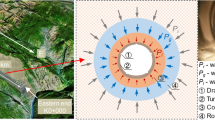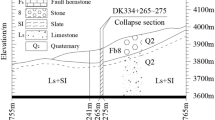Abstract
Presented and discussed are aspects of changes to the hydraulic properties of rock mass due to tunnelling, but in particularly the change due to the opening or making of new fractures and voids in the rock mass as a result of deformation or relaxation of the tunnel opening and hence an associated increase in the permeability of the rock mass surrounding the tunnel. This process principally occurs in tunnels were high stress fields persist effecting rapid and large scale deformation or relaxation (>100 mm) in the presence of (heavily) jointed rock mass and fault zones. Examples and observations from water and ground inflow events, associated with hydraulic property changes which have occurred during the mining of the Tapovan-Vishnugad Head Race Tunnel, India, are given and which have caused trapping of the Tunnel Boring Machine (TBM) resulting in time delays and cost increases.
Access this chapter
Tax calculation will be finalised at checkout
Purchases are for personal use only
Similar content being viewed by others
References
Brandl J, Gupta VK, Millen B (2010) Tapovan-Vishnugad hydroelectric power project—experience with TBM excavation under high rock cover. Geomech Tunn 3(5):501–509
Darcy H (1856) Les Fontaines Publiques de la Ville de Dijon (in French) [The Public Fountains of the City of Dijon], Dalmont, Paris
Gysel M (2002) Anhydrite dissolution phenomena: three case histories of anhydrite karst caused by water tunnel operation. Rock Mech Rock Eng 35(1):1–21
Heim A, Gansser A (1939) Central Himalaya. Soc Helv Sci Nat Zurich 73:1–245
Howard AJ (1991) ITA working group on maintenance and repair of underground structures. Report on the damaging effects of water on tunnels during their working life, vol 6, no I, pp 11–76. Tunnelling and Underground Space Technology
Lipponen A, Manninen S, Niini H, Rönkä E (2005) Effect of water and geological factors on the long-term stability of fracture zones in the Päijänne Tunnel, Finland: a case study. Int J Rock Mech Min Sci 42:3–12
Millen B, Brandl J (2011) TBM recovery under high cover and extreme water-inflow, Himalayas, India. In: Kolić D (ed) 1st international Congress on tunnels and underground structures in South-East Europe “using underground space” April 7–9. Dubrovnik, Croatia, p 10. PDF on USB-Stick on back cover of book, ISBN 978-953-55728-6-2
Prinz H (1997) Abriß der Ingenieurgeologie (in German) [synopsis of engineering geology], 3rd edn, p 545. Ferdinand Enke Verlag, Stuttgart
Schwarz L, Reichl I, Kirschner H, Robl KP (2006) Risks and hazards caused by groundwater during tunnelling: geotechnical solutions used as demonstrated by recent examples from Tyrol, Austria. Environ Geol 49:858–864
Wenner D, Wannenmacher H (2009) Alborz service tunnel in Iran: TBM tunnelling in difficult ground conditions and its solutions: 1st regional and 8th Iranian tunneling Conference, vol 18, 20 May, Tehran, Iran
Witherspoon PA, Wang JSY, Iwail K, Gale JE (1980) Validity of cubic law for fluid flow in a deformable rock fracture. Water Resour Res 16:1016–1024
Wittke W (1984) Felsmechanik: Grundlagen für wirtschaftliches Bauen im Fels (in German) [rock mechanics: principles for economic construction in rock], p 1050. Springer, Berlin
Yin A (2006) Cenozoic tectonic evolution of the Himalayan orogen as constrained by along-strike variation of structural geometry, exhumation history, and foreland sedimentation. Earth-Sci Rev 76:1–131
Acknowledgements
The authors are indebted to various staff of NTPC Ltd., Larsen & Toubro Ltd., Alpine—Mayreder GmbH, Herrenknecht AG and Geoconsult ZT GmbH for providing data for this paper.
Author information
Authors and Affiliations
Corresponding author
Editor information
Editors and Affiliations
Rights and permissions
Copyright information
© 2015 Springer International Publishing Switzerland
About this paper
Cite this paper
Millen, B., Höfer-Öllinger, G., Brandl, J. (2015). Change in Hydraulic Properties of Rock Mass Due to Tunnelling. In: Lollino, G., et al. Engineering Geology for Society and Territory - Volume 6. Springer, Cham. https://doi.org/10.1007/978-3-319-09060-3_170
Download citation
DOI: https://doi.org/10.1007/978-3-319-09060-3_170
Published:
Publisher Name: Springer, Cham
Print ISBN: 978-3-319-09059-7
Online ISBN: 978-3-319-09060-3
eBook Packages: Earth and Environmental ScienceEarth and Environmental Science (R0)




